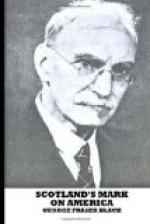at the end of a long career passed as a mechanical
engineer, and achieved success and fame in his profession,
was born in Ayr, Scotland. He probably inherited
his mechanical skill from his uncle, John Taylor of
Dalswinton, who constructed the steam engine along
with Symington. James Henry McLean (1829-86),
physician and Member of Congress, was born in Scotland.
Dr. James Craig (1834-88), obstetrician, born in Glasgow,
graduated at the University of the City of New York,
attended over four thousand cases without the loss
of a mother, was inventor of several surgical appliances,
and was the first to demonstrate hydriodic acid as
a curative in acute inflammatory rheumatism.
Professor Alexander Johnson Chalmers Skene (1837-1900),
of Brooklyn, born in Fyvie, Aberdeenshire, was perhaps
the most famous Gynecologist in America. He was
author of many treatises on his special subject.
Prof. Charles McBurney (b. 1845), the famous surgeon,
was of Scottish ancestry. Neil Jamieson Hepburn,
born in Orkney in 1846, oculist and aurist, held many
positions of responsibility. Charles Smith Turnbull
(b. 1847), oculist and eminent specialist in diseases
of the ear, was of Scottish parentage. Alexander
Hugh Ferguson (1853-1911), the famous Chicago surgeon
of Scottish parentage, was decorated by the King of
Portugal for his skill in surgery. Other prominent
doctors and surgeons of Scottish origin whom we have
only space to name are: John Barclay Crawford
(1828-94); William Smith Forbes (1831-1905), grandson
of Dr. David Forbes of Edinburgh; John Minson Gait
(d. 1808), and his son Alexander D. Gait (1777-1841);
Robert Ramsey Livingston (1827-88), the most prominent
of Nebraska’s early physicians; and James Macdonald
(1803-49), resident physician of Bloomingdale Asylum.
SCOTS IN EDUCATION
The Scots have largely contributed to raise the standard
of education and culture in the United States.
They furnished most of the principal schoolmasters
in the Revolutionary Colonies south of New York, and
many of the Revolutionary leaders were trained by them.
While Harvard still continued under the charge of
a president and tutors and had but one “professor,”
William and Mary College had had for many years a
full faculty of professors, graduates of the Scottish
and English universities. The Scots established
the “Log College” at Nashaminy, Pennsylvania,
Jefferson College, Mercer College, Wabash College,
and Dickinson College; and in many places, before
the cabins disappeared from the roadside and the stumps
from the fields, a college was founded. The “Log
College” was the seed from which Princeton College
sprang. The University for North Carolina, founded
and nurtured by Scots in 1793, and the University
of Pennsylvania and Princeton University are indebted
to the same source for their present position.
William Gordon and Thomas Gordon, who founded a free
school in the county of Middlesex, Virginia, in the




